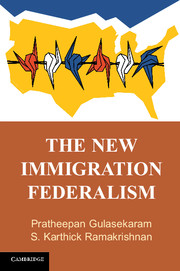Book contents
- Frontmatter
- Dedication
- Contents
- List of Figures and Tables
- Acknowledgments
- 1 Introduction
- 2 Setting the Stage for the New Immigration Federalism
- 3 Rise of Restrictive Legislation and Demographic Arguments of “Vital Necessity”
- 4 A Political Theory of Immigration Federalism: The Polarized Change Model and Restrictive Issue Entrepreneurs
- 5 A Shifting Tide in 2012: Pro-Integration Activists Gain the Upper Hand
- 6 Implications for Legal Theory on Federalism and Immigration Law
- 7 Immigration Federalism Is Here To Stay
- Appendix A Statistical Analysis of Restrictive Local Ordinances
- Appendix B Statistical Analysis of Restrictive State Laws
- Appendix C Statistical Analysis of State Immigrant Integration Laws
- Notes
- Index
7 - Immigration Federalism Is Here To Stay
Published online by Cambridge University Press: 05 November 2015
- Frontmatter
- Dedication
- Contents
- List of Figures and Tables
- Acknowledgments
- 1 Introduction
- 2 Setting the Stage for the New Immigration Federalism
- 3 Rise of Restrictive Legislation and Demographic Arguments of “Vital Necessity”
- 4 A Political Theory of Immigration Federalism: The Polarized Change Model and Restrictive Issue Entrepreneurs
- 5 A Shifting Tide in 2012: Pro-Integration Activists Gain the Upper Hand
- 6 Implications for Legal Theory on Federalism and Immigration Law
- 7 Immigration Federalism Is Here To Stay
- Appendix A Statistical Analysis of Restrictive Local Ordinances
- Appendix B Statistical Analysis of Restrictive State Laws
- Appendix C Statistical Analysis of State Immigrant Integration Laws
- Notes
- Index
Summary
We end this book by taking stock and looking forward. First, we revisit the question of what, exactly, is “new” about the new immigration federalism that warrants deeper examination and a distinct focus from prior developments in state legislation that targeted immigrants. We then provide an overview of the constitutional landscape of immigration federalism, with consideration of what is legally permissible for states and localities to enact given immigration law and decisions in federal court. Finally, we consider the future of immigration federalism in the United States, given recent developments and future prospects for comprehensive immigration reform, changes in presidential power vis-à-vis Congress, and political dynamics at the state and local level.
What Is “New” about Immigration Federalism?
As we noted in Chapter 2, we can think of the third era in immigration federalism as beginning around 1965. That was the year when Congress passed a wide-ranging immigration overhaul, abolishing national origin quotas but also creating the conditions for a new and rapidly growing problem of unauthorized immigration by setting numerical limits on migration from the Western hemisphere, and dismantling the Bracero Program. Thus, even though the 1965 law did not explicitly address state and local policies involving immigrants, it nevertheless provided the opening for a new set of federalism dynamics as states such as California and Texas began passing legislation targeting unauthorized immigrants.
Subsequent laws by Congress, including the 1986 Immigration Reform and Control Act and the 1996 immigration overhaul expressly accounted for the possibility of subfederal lawmaking. This kind of direct response to state action on immigration was a relatively new dynamic in congressional legislation, one that had not been seen since the federal government had taken exclusive authority over immigration law in the late 1800s. A critical difference, however, lay in what Congress began allowing states to do. While congressional legislation from the late nineteenth century prevented states such as California from meddling in immigration policy vis-à-vis countries such as China, the laws in 1986 and 1996 provided openings for states to get more involved. This was most explicitly evident in the 1996 immigration law that created the 287(g) program of coordinated enforcement between the federal government and local law enforcement. The 1996 law also wiped the slate clean on state benefits for unauthorized residents, forcing states to affirmatively pass new legislation if they wanted to restore those benefits or create new ones.
- Type
- Chapter
- Information
- The New Immigration Federalism , pp. 195 - 206Publisher: Cambridge University PressPrint publication year: 2015



